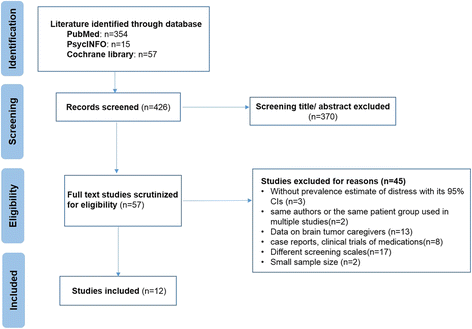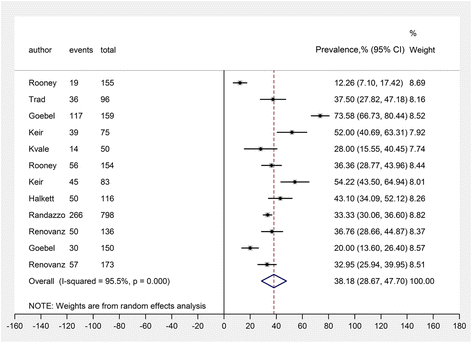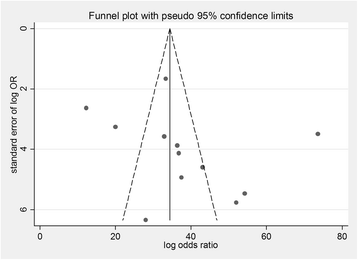Screening for distress in patients with primary brain tumor using distress thermometer: a systematic review and meta-analysis
- PMID: 29394923
- PMCID: PMC5797347
- DOI: 10.1186/s12885-018-3990-9
Screening for distress in patients with primary brain tumor using distress thermometer: a systematic review and meta-analysis
Abstract
Background: Patients with primary brain tumors are reported to have an elevated level of distress prevalence, due to the functional sequelae and the unfavorable prognosis, but the estimated prevalence of this disorder varies among studies. The Distress Thermometer (DT) is widely used distress screening tools to identify patients suffering from elevated psychosocial distress. The objective of this meta-analysis is to get a summarized estimate of distress prevalence in adult primary brain tumor patients screened by the DT instrument to identify distress in brain tumor patients.
Method: We searched studies published in PubMed, PsycINFO, and Cochrane library through August 2017 and checked related reviews and meta-analyses for eligible studies. Studies were eligible if they were published in the peer-reviewed literature and evaluated distress level by Distress Thermometer. The prevalence of distress symptoms in patients with the intracranial tumor was estimated by study-level characteristics using stratified meta-analysis. The prevalence of distress level or symptoms during the follow-up examination at different time points was detected by secondary analysis of the longitudinal studies included.
Results: Twelve studies including a total of 2145 brain tumor patients were included in this analysis. Eight used a cross-sectional design and four were longitudinal. The pooled prevalence of distress was 38.2% (95% confidence interval (CI) 28.7%-47.7%) for the overall sample. The pooled prevalence of distress DT ≥4 was 41.1% (642/1686, 95% CI 28.6%-53.5%) and the pooled prevalence of distress by DT ≥6 was 29.7% (137/459, 95% CI 19.5%-39.9%). The distress symptom did not decrease in follow-up studies (Relative Increase Ratio:1.02, 95% CI, (0.78, 1.35)). A huge heterogeneity in different studies was detected, and different screening scales were not compared.
Conclusion: The high prevalence of distress becomes an enormous challenge for primary brain tumor patients. Routine screening and evaluation of distress in brain tumor patients may assist medical workers to develop proper interventions, which may lead to better quality of life and oncology management.
Keywords: Distress; Distress thermometer; Glioblastoma; Meta-analysis; Primary brain tumor.
Conflict of interest statement
Ethics approval and consent to participate
Not applicable.
Consent for publication
Not applicable.
Competing interests
The authors declare that they have no competing interests.
Publisher’s Note
Springer Nature remains neutral with regard to jurisdictional claims in published maps and institutional affiliations.
Figures



References
Publication types
MeSH terms
Grants and funding
LinkOut - more resources
Full Text Sources
Other Literature Sources
Medical

